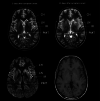Healthcare-associated exposure to Borna disease virus 1 (BoDV-1)
- PMID: 35681207
- PMCID: PMC9178218
- DOI: 10.1186/s12995-022-00353-3
Healthcare-associated exposure to Borna disease virus 1 (BoDV-1)
Abstract
The Borna disease virus 1 (BoDV-1) causes severe and often fatal encephalitis in humans. The virus is endemic in parts of Germany, Liechtenstein, Switzerland and Austria. As an increasing number of human BoDV-1 encephalitis cases is being diagnosed, the chance for healthcare professionals to come into contact with infected tissues and bodily fluids from patients with known acute bornavirus encephalitis is also increasing. Therefore, risk assessments are needed. Based on three different incidences of possible exposure to BoDV-1 including an autopsy knife injury, a needlestick injury, and a spill accident with cerebrospinal fluid from patients with acute BoDV-1 encephalitis, we perform risk assessments and review published data. BoDV-1 infection status of the index patient's tissues and bodily fluids to which contact had occurred should be determined. There is only scarce evidence for possible postexposure prophylaxis, serology, and imaging in healthcare professionals who possibly came into contact with the virus. Despite decade-long laboratory work with BoDV-1, not a single clinically apparent laboratory infection has been published. Given the increasing number of severe or fatal BoDV-1 encephalitis cases, there is a growing need for efficacy-tested, potent antiviral therapeutics against BoDV-1 in humans, both in clinically ill patients and possibly as postexposure prophylaxis in healthcare professionals.
Keywords: Bornavirus; Favipiravir; Imaging; Postexposure prophylaxis; Serology.
© 2022. The Author(s).
Conflict of interest statement
The authors have no competing interests; there are no relevant financial or non-financial interests to disclose.
Figures



Similar articles
-
BoDV-1 Infection in Children and Adolescents: A Systematic Review and Meta-Analysis.Pediatr Rep. 2023 Sep 1;15(3):512-531. doi: 10.3390/pediatric15030047. Pediatr Rep. 2023. PMID: 37755407 Free PMC article. Review.
-
Detection of bornavirus-reactive antibodies and BoDV-1 RNA only in encephalitis patients from virus endemic areas: a comparative serological and molecular sensitivity, specificity, predictive value, and disease duration correlation study.Infection. 2024 Feb;52(1):59-71. doi: 10.1007/s15010-023-02048-1. Epub 2023 May 30. Infection. 2024. PMID: 37253816 Free PMC article.
-
Human Borna disease virus 1 (BoDV-1) encephalitis cases in the north and east of Germany.Emerg Microbes Infect. 2022 Dec;11(1):6-13. doi: 10.1080/22221751.2021.2007737. Emerg Microbes Infect. 2022. PMID: 34783638 Free PMC article.
-
Zoonotic spillover infections with Borna disease virus 1 leading to fatal human encephalitis, 1999-2019: an epidemiological investigation.Lancet Infect Dis. 2020 Apr;20(4):467-477. doi: 10.1016/S1473-3099(19)30546-8. Epub 2020 Jan 7. Lancet Infect Dis. 2020. PMID: 31924550
-
Reverse Genetics and Artificial Replication Systems of Borna Disease Virus 1.Viruses. 2022 Oct 12;14(10):2236. doi: 10.3390/v14102236. Viruses. 2022. PMID: 36298790 Free PMC article. Review.
Cited by
-
BoDV-1 Infection in Children and Adolescents: A Systematic Review and Meta-Analysis.Pediatr Rep. 2023 Sep 1;15(3):512-531. doi: 10.3390/pediatric15030047. Pediatr Rep. 2023. PMID: 37755407 Free PMC article. Review.
-
Human Infections with Borna Disease Virus 1 (BoDV-1) Primarily Lead to Severe Encephalitis: Further Evidence from the Seroepidemiological BoSOT Study in an Endemic Region in Southern Germany.Viruses. 2023 Jan 9;15(1):188. doi: 10.3390/v15010188. Viruses. 2023. PMID: 36680228 Free PMC article.
-
First detected geographical cluster of BoDV-1 encephalitis from same small village in two children: therapeutic considerations and epidemiological implications.Infection. 2023 Oct;51(5):1383-1398. doi: 10.1007/s15010-023-01998-w. Epub 2023 Feb 23. Infection. 2023. PMID: 36821024 Free PMC article.
-
Detection of bornavirus-reactive antibodies and BoDV-1 RNA only in encephalitis patients from virus endemic areas: a comparative serological and molecular sensitivity, specificity, predictive value, and disease duration correlation study.Infection. 2024 Feb;52(1):59-71. doi: 10.1007/s15010-023-02048-1. Epub 2023 May 30. Infection. 2024. PMID: 37253816 Free PMC article.
References
-
- Schlottau K, Forth L, Angstwurm K, Höper D, Zecher D, Liesche F, Hoffmann B, Kegel V, Seehofer D, Platen S, Salzberger B, Liebert UG, Niller HH, Schmidt B, Matiasek K, Riemenschneider MJ, Brochhausen C, Banas B, Renders L, Moog P, Wunderlich S, Seifert CL, Barreiros A, Rahmel A, Weiss J, Tappe D, Herden C, Schmidt-Chanasit J, Schwemmle M, Rubbenstroth D, Schlegel J, Pietsch C, Hoffmann D, Jantsch J, Beer M. Fatal encephalitic Borna disease virus 1 in solid-organ transplant recipients. N Engl J Med. 2018;379(14):1377–1379. doi: 10.1056/NEJMc1803115. - DOI - PubMed
-
- Eisermann P, Rubbenstroth D, Cadar D, Thomé-Bolduan C, Eggert P, Schlaphof A, Leypoldt F, Stangel M, Fortwängler T, Hoffmann F, Osterman A, Zange S, Niller HH, Angstwurm K, Pörtner K, Frank C, Wilking H, Beer M, Schmidt-Chanasit J, Tappe D. Active case finding of current Bornavirus infections in human encephalitis cases of unknown etiology, Germany, 2018-2020. Emerg Infect Dis. 2021;27(5):1371–1379. doi: 10.3201/eid2705.204490. - DOI - PMC - PubMed
-
- Niller HH, Angstwurm K, Rubbenstroth D, Schlottau K, Ebinger A, Giese S, Wunderlich S, Banas B, Forth LF, Hoffmann D, Höper D, Schwemmle M, Tappe D, Schmidt-Chanasit J, Nobach D, Herden C, Brochhausen C, Velez-Char N, Mamilos A, Utpatel K, Evert M, Zoubaa S, Riemenschneider MJ, Ruf V, Herms J, Rieder G, Errath M, Matiasek K, Schlegel J, Liesche-Starnecker F, Neumann B, Fuchs K, Linker RA, Salzberger B, Freilinger T, Gartner L, Wenzel JJ, Reischl U, Jilg W, Gessner A, Jantsch J, Beer M, Schmidt B. Zoonotic spillover infections with Borna disease virus 1 leading to fatal human encephalitis, 1999-2019: an epidemiological investigation. Lancet Infect Dis. 2020;20(4):467–477. doi: 10.1016/S1473-3099(19)30546-8. - DOI - PubMed
Publication types
LinkOut - more resources
Full Text Sources
Research Materials

